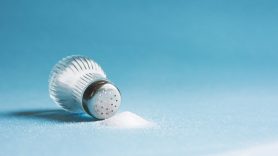4 tips to reduce sodium and lower your cancer risk
You need sodium in your diet, but too much can increase your stomach cancer risk. Get tips to cut some of the sodium from your diet.

Sodium is an essential mineral that helps your muscles function and controls fluid balances. But too much sodium can increase your risk of heart attack and stroke. It can also increase your risk of stomach cancer and other diseases.
Sodium is typically associated with salt, but the two aren’t the same thing. Table salt is a common food flavoring that contains sodium. Table salt may also have added iodine and anti-clumping agents. One teaspoon of salt contains 2,300 mg of sodium.
The Centers for Disease Control and Prevention recommends limiting the amount of sodium in your diet to less than 2,300 milligrams a day. That’s a little less than 1 teaspoon. But many Americans get too much sodium. In fact, most get 3,400 milligrams a day.
"People don’t realize how much sodium they’re taking in" says Lindsey Wohlford, MD Anderson Cancer Center employee Wellness Dietitian. “Sometimes, it seems like it’s hidden in certain foods.”
Fortunately, there are several simple ways to cut down on your sodium or salt intake. Read these tips to improve your health and help lower your cancer risk.
Cook at home
Cooking at home gives you more control over how much salt is in your food. Wohlford says she recommends using onions, garlic, herbs, spices and vinegar to flavor foods instead of using extra salt. She also suggests avoiding spice blends that include salt. For example, choose onion powder over onion salt.
Choose your foods carefully at the grocery store
Whenever possible, choose fresh foods. Processed, prepared and packaged foods are some of the biggest sources of extra sodium to our diets, Wohlford says. If you do choose processed foods, look for "low-sodium" or "no salt added" on the labels. And be sure to drain and rinse any canned vegetables in fresh water.
Read the packaging, including the nutrition label
"You’ll see many different comments about sodium on packaged food labels," Wohlford says. "Sometimes, it can be difficult to decode them."
Here’s what these commonly used phrases actually mean:
- "Sodium free" or "salt free" means there is less than 5 milligrams of sodium per serving.
- "Unsalted" or "no salt added" means exactly as it says, no salt added.
- "Very low in sodium" means a serving contains 35 milligrams of sodium or less.
- "Low in sodium" means a serving has 140 milligrams of sodium or less.
- "Reduced sodium or "less sodium" means that this product has at least 25% less sodium than the traditional product.
The amount of sodium is listed on the nutrition label in milligrams. A rule of thumb is to avoid foods that contain a serving of sodium that is greater than twice the number of calories.
Sodium may be listed in the ingredients as salt, baking soda, baking powder, monosodium glutamate (MSG) or disodium phosphate.
Avoid cured food
Cured foods, like bacon and lunch meat, are notorious for containing high amounts of sodium. The sodium nitrates are what give them a longer shelf life, but they’re far from heart healthy. And, on top of that, they can contribute to your cancer risk. A report from the World Health Organization showed that processed meats are carcinogenic to humans and can increase your risk of colorectal cancer by 18%.
"Cutting salt can seem like a difficult task at first," Wohlford says. "But by following these simple steps, you can make a difference when it comes to your heart health and your cancer risk."



